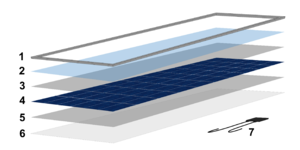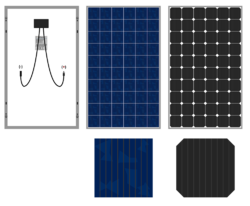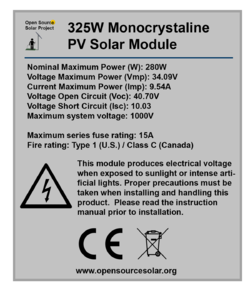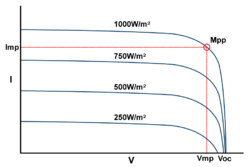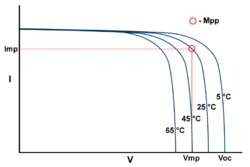PV module
Solar PV modules use the photovoltaic (PV) effect to generate electrical current upon exposure to light. When sufficient light hits a PV cell, current is generated which excites electrons that then pass through a one-way barrier or junction forcing them to flow through a circuit to return to their point of origin. These movement of these electrons can be used to do work or power loads. There are many different technologies available and ways to design a system that can meet needs that range from simple lighting, to running appliances, pumping water or powering cities.
PV modules are composed of individual cells wired together in series with each one producing around.5V when exposed to sufficient light. PV modules come in several common configurations:
- A 36-cell module comprised of .5 V cells will have a rated Vmp of around 18V.
- A 60-cell module comprised of .5 V cells will have a rated Vmp of around 30V.
- A 72-cell module comprised of .5 V cells will have a rated Vmp of around 36V.
The PV source for an off-grid system - the PV module(s) or array - must be sized and selected in conjunction with the charge controller - see PV source and charge controller sizing and selection for more information.
Contents
Types
There are many different chemistries that are used in PV cells, but there are two main categories of modules that are found on the market. Each type of solar module continues to have different characteristics that can be attractive depending upon the circumstances such as lower price or higher efficiency.
- Crystalline silicon modules
- The most common type of module on the market. These modules can come in poly or monocrystalline construction. The names are derived from the way that they are manufactured with monocrystalline cells being cut from a single crystal and polycrystalline cells being comprised of silicon from various crystals. Both types are composed of a few simple materials (average by weight): 76% glass (panel surface), 10% polymer (encapsulant and backsheet foil), 8% aluminum (mostly the frame), 5% silicon (solar cells), 1% copper (interconnectors) and less than 0.1% silver (contact lines) and other metals (mostly tin and lead) [1]
- Monocrystalline modules are more expensive, but achieve higher average efficiencies around 17-20%.
- Polycrystalline modules are less expensive and are less efficient with average efficiencies around 16-17%.
- The most common type of module on the market. These modules can come in poly or monocrystalline construction. The names are derived from the way that they are manufactured with monocrystalline cells being cut from a single crystal and polycrystalline cells being comprised of silicon from various crystals. Both types are composed of a few simple materials (average by weight): 76% glass (panel surface), 10% polymer (encapsulant and backsheet foil), 8% aluminum (mostly the frame), 5% silicon (solar cells), 1% copper (interconnectors) and less than 0.1% silver (contact lines) and other metals (mostly tin and lead) [1]
- Thin film modules
- Thin film modules are built out by laying photovoltaic material in one or more layers on a supporting material such as glass, plastic, or metal. Thin film modules come in various types with Cadmium-Telluride (CdTe) Being the most common. CdTe modules contain far less aluminum and more glass than Crystalline silicon modules (average by weight): 97% glass (panel surface), ~3% polymer (junction boxes and sealant) and negligible amounts of semiconductors and metals. [1] Thin film modules are far less efficient than crystalline silicon modules at around 9% efficiency, but significantly cheaper.
Standard test conditions
PV modules are rated in terms of watts (W) under industry determined laboratory test conditions called standard test conditions (STC). The three conditions are the strength of sunlight called irradiance, cell temperature and airmass. Airmass is fixed for a given location, so it plays a less important role than the other two. PV modules will only produce their rated power at their Maximum Power Point, which is Vmp multiplied by Imp, under standard test conditions laboratory. These conditions are not frequently reached in most locations as cell temperatures rise quickly when exposed to sunlight and irradiance of 1000 W/m² only occurs when the sky is clear near midday. Therefore, the curve shown the preceding graphics will shift depending upon the conditions.
A module is tested and rated based upon the following values which can be found printed on the module or in its specifications sheet:
- Open circuit voltage (Voc) – The voltage that the module will produce under STC when it is not connected to a circuit.
- Short circuit current (Isc) – The current that a module will produce under STC when it is short-circuited or with its positive output directly connected to its negative.
- Maximum power voltage (Vmp) – The voltage that the module will produce when connected to a circuit under STC.
- Maximum power current (Imp) – The current that the module will produce when connected to a circuit under STC.
- Temperature coefficient of power (P) - A coefficient that accounts for how module power responds to increases and decreases in temperature in %/°C or V/°C.
- Temperature coefficient of open circuit voltage (Voc) - A coefficient that accounts for how module voltage responds to increases and decreases in temperature in %/°C or V/°C.
Irradiance
Irradiance is a measurement of sunlight intensity (power) that constantly varies throughout the day naturally as the sun moves through the sky, but also due to weather. Irradiance measured over time is referred to as insolation and is vitally important for measuring PV system production over time. On a clear day irradiance typically will reach its peak around noon. 1000 W/m² is an irradiance value for a clear day around noon, which means that it is not likely to be normal operating condition in most locations. Irradiance can only be measured with specialized and sensitive equipment, but it can be estimated as irradiance has a direct relationship with the current and power that the module outputs. PV module are given their power ratings by testing them at 1000 W/m² of irradiance. Irradiance below 1000 W/m² reduces cell current and irradiance above 1000 W/m² increases cell current. Irradiance can increase beyond 1000 W/m² under certain geographic and meteorological conditions. The formula for calculating production based upon irradiance is:
Irradiance loss factor = measured W/m² ÷ 1000 W/m²
- Example 1: A PV module is rated at 200 W. Irradiance is measured at 750 W/m² and the temperature of the PV module is measured at 25°C. What should the power output of the module be?
- Irradiance loss factor = 750 W/m² ÷ 1000 W/m² = .75
- Power adjusted for decreased irradiance = 200 W × .75
- Power adjusted for decreased irradiance = 150 W
- Example 1: A PV module is rated at 200 W. Irradiance is measured at 750 W/m² and the temperature of the PV module is measured at 25°C. What should the power output of the module be?
Cell temperature
Cell temperature is the no more complicated than it sounds - the temperature of the solar cells. Cell temperature can be easily measured and has a direct relationship with voltage. Cell temperatures above 25°C decrease cell voltage and cell temperatures above 25°C increase cell voltage. If cell temperatures are below 25°C, it is possible for a to exceed the modules rated Open Circuit Voltage (Voc). Losses due to increased cell temperature greatly decrease solar cell production in nearly all solar installations. The formula for calculating losses due to increased cell temperatures is:
Temperature loss factor = measured cell temperature - 25°C × temperature coefficient of max power (TkPmp)
- TkPmp is a value from the module specifications sheet and is typically in the form of %/°C.
- Example 1: A PV module is rated at 200W. Cell temperature is measured at 35 °C. The specifications for the module state that it has a TkPmp of -.48 %/°C. What should the power output of the module be?
- Temperature loss factor = 35°C - 25°C × -.48 %/°C
- Temperature loss factor = -4.8%. Production will be 95.2% of STC power.
- Power adjusted for high temperatures = 200 W × .952
- Power adjusted for high temperatures = 190.4 W
- Example 1: A PV module is rated at 200W. Cell temperature is measured at 35 °C. The specifications for the module state that it has a TkPmp of -.48 %/°C. What should the power output of the module be?
Air mass
Air mass is a measurement of the amount of the atmosphere that light from the sun has to pass through before reaching the PV module. It does vary globally, but it isn't relevant here as it isn't a factor that significantly varies for a given location from year to year.
Projected life
A well-made silicon solar module will continue functioning over 25 years, although all modules degrade with the passage of time. High-quality modules degrade at an average rate of .5% to 1% per year, whereas poorly made modules degrade even quicker. This is the primary difference between the different costs and qualities of modules.
Maintenance
PV modules are built out of durable materials and have no moving parts. The only maintenance that is likely to ever be required a module is an occasionally cleaning if the module is in an area that lacks regular rainfall.
Recyclability
PV modules should be treated as electronic waste and should not be discarded with normal trash. The process for recycling a PV module consists of breaking it down into its main components and then sending them through the appropriate recycling streams. The majority of a crystalline silicon module can be recycled - an estimated 85%.[1] In many areas where PV is being used to facilitate energy access, there are insufficient regulations and therefore a complete lack of a market and infrastructure to handle PV module waste.
Notes/references
- ↑ 1.0 1.1 1.2 IRENA End-of-Life Management Solar Photovoltaic Panels. https://www.irena.org/-/media/Files/IRENA/Agency/Publication/2016/IRENA_IEAPVPS_End-of-Life_Solar_PV_Panels_2016.pdf
